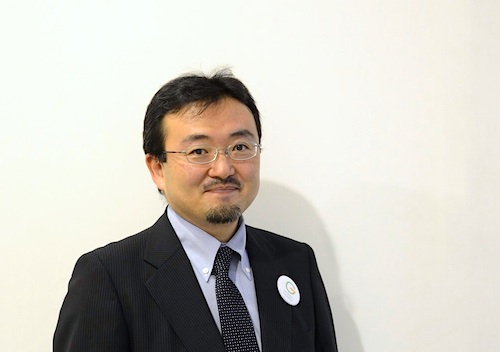
from Japan vol. 65 2014.02.04 The power to build a new future. Let's make renewable energy more widespread!
![]()
There is growing interest in renewable energy created from sunlight, wind, or geothermal heat as a new power source that will help realize a lifestyle with better energy security. What’s giving this movement an extra boost is the “Green Power Project” spearheaded by the Ministry of Economy, Trade and Industry’s Agency for Natural Resources and Energy, and promoted by both the public and private sectors. Think the Earth is also taking part in this initiative and edited and produced the visual book, “Green Power Book – Introduction to Renewable Energy."
This report features an interview with Mr. Keisuke Murakami from the Agency for Natural Resources and Energy, who has worked to promote understanding for and implementation of renewable energy through various activities. We will also be introducing the experimental study on a floating offshore wind power generation plant in Fukushima, as well as the activities of Fujino Denryoku, a group of people who has created the movement, “Do it ourselves, electricity!” which encourages people to make the shift towards green energy.
目次へ移動 Interview: Mr. Keisuke Murakami
目次へ移動 Japan's renewable energies have excellent potential
Q: What is the Green Power project?
Murakami: At the moment, renewable energy only make up about 1.6% of all electricity generated in Japan, but because Japan is richly endowed by nature and boasts excellent technological competence, there is great potential for renewable energy in Japan. Renewable energy is critical to ensuring a sustainable future of a country such as Japan that has limited energy resources. What is equally important is improving the energy literacy of each individual.
The public and private sector joined hands and launched the "Green Power Project" in the fall of 2013 to achieve these ends. The project undertakes a wide range of activities to promote understanding for the feed-in-tariff, which began in the summer of 2012 and to make renewable energy more widespread.
The project also organizes educational programs for parents and children of the community to promote understanding for renewable energy. For example, they organize quizzes and classes on renewable energy at schools, and give children an opportunity to experience a simplified solar power generation system.
This project also aims to create a new green industry and market in Japan. To help developers of renewable energy, the project organizes workshops on building solar panels and schools for people who are considering entering the renewable energy business. Many people have taken part in these activities so far.
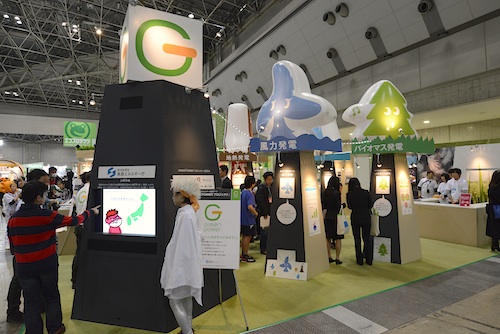 The "Green Power Project's booth" at Japan's largest eco tradeshow, Eco-Products 2013.
The "Green Power Project's booth" at Japan's largest eco tradeshow, Eco-Products 2013.
Q: What are the benefits of renewable energy becoming more widespread in Japan?
Murakami: First of all, we'll be able to improve our energy self-sufficiency. Japan's energy self-sufficiency is currently only around 4%. Japan imports nearly all of the fossil fuels like petroleum and natural gas it consumes from the Middle East and Asia. Amid soaring oil prices, Japan pays 3.6 trillion yen more each year to import fossil fuels from abroad. And the damage Japan and its economy would incur will only worsen in the future. In order to mitigate such damage, we need to diversify our energy resources, and increase domestic production of energy as much as possible. Fortunately Japan is endowed by nature. We can use solar, wind, geothermal, and hydraulic power as well as biomass. If we could use such energy sources more effectively, this will help improve the share of domestically produced energy and thereby boost Japan's self-sufficiency.
Moreover, renewable energy has amazing potential to create a new industry. The green industry requires sophisticated technology, so Japan, with its technological prowess, has quite an advantage. And if such technology can be exported abroad, this can become a big industry for Japan.
Another characteristic of renewable energy is it allows rural communities to get involved. Whether its solar power, wind power, or geothermal power generation, rural areas with an abundance of natural resources have excellent potential. If renewable power generation flourishes in rural areas, they would be better equipped to attract companies and factories, giving them more choices, and helping their towns and regions develop.
And last but not least, global warming is an issue that goes hand in hand with energy discussions. Shifting from fossil fuels that emit large quantities of CO2 to renewable energy such as solar and wind power will help put a stop to global warming. More and more, weather abnormalities are being witnessed all around the world, so the shift from fossil fuels to renewable energy is now becoming a global energy policy.
Q: Why is there such a rush to make renewable energy more widespread?
Murakami: To secure a stable source of energy. Japan's energy self-sufficiency is only 4%, so if the supply of fossil fuels or natural gas from abroad is interrupted due to unforeseen turn of events, it is clear that after a while, our lives and various industries will become affected.
Rising fossil fuel prices will also dramatically affect Japan's national power. Furthermore, as demand for energy among emerging countries such as China and India is expected to rise, it will become increasingly difficult in the future to procure energy from abroad.
That is why it would be prudent to improve Japan's energy self-sufficiency as soon as possible. There has been a lot of talk about how renewable energy is green, but we're now at a stage where we have to take another step forward.
Another thing we shouldn't forget is that deposits of fossil fuels, like petroleum, natural gas, as well as methane hydrate and shale gas, which have drawn attention as a type of new energy, are finite. Green energy like solar and wind power, on the other hand, is infinite. It is true that in comparison to fossil fuels that Earth has accumulated and compressed over millions of years renewable energy such as wind and solar energy are less efficient. However, water that flows from the precipitous mountains and the geothermal heat that lies underground are resources unique to the volcanic nation that Japan is. In addition, biomass creates energy from waste wood materials and left over food, which we certainly do have on a daily basis. So when we think about it, Japan is actually rich in energy resources.
It would be a pity not to use these resources effectively. In order to do so, we need more people to get involved in the renewable energy industry, and this requires a strong foundation that makes good business sense. To cultivate renewable energy as an important source of energy for Japan, we need policies that promote renewable energy and the understanding of each and every Japanese citizen.
目次へ移動 Energy shift issues
Q: What needs to be done to make renewable energy more widespread?
Murakami: The key to making renewable energy more widespread is wind power generation, that is, if large-scale development that would offer benefits from economies of scale becomes possible. Actually, the key pillar of renewable energy in Europe and many other parts of the world is wind power generation because it can produce large amounts of energy at very low costs. In Japan, however, solar power generation has become more prevalent because it requires less construction and time-consuming procedures. Of course, we should promote solar power generation as well, but in order to make renewables more widespread, we have to promote large-scale wind power generation projects. And this actually requires "power grid upgrades" and "deregulation."
There are 2 issues with "upgrading the power grid." First of all, we need to reinforce the power grid in each region. Wind power generation can become cost effective if it can be developed on a large scale. The optimal locations for this in Japan are mainly Hokkaido-Tohoku regions. These regions have the potential to create more renewable energy that surpasses demand. But unfortunately the population in these areas is low, and hence so is the demand for energy, so the power grid has a very low capacity. This is why although these areas have great potential, no one has built a wind power generation plant.
As long as the capacity of power grids remain low, it is difficult not only for wind power generation, but other renewables such as solar power and biomass to take root. So what we need to start with is increasing the capacity of the power grid. In recent years, as a first step in the right direction, the public and private sectors have started working together to build a new power grid and to reinforce the existent grid. It will be interesting to see how this project will progress in the future.
Another issue is interregional transfer of energy. The amount of energy created by renewable energy such as wind and solar power generation is affected by natural conditions. But to be able to provide a stable supply of electricity, it is also important to keep the supply and demand balanced. Unfortunately, electricity can't be stored. So if a lot of solar panels or wind turbines are installed and if the amount of energy generated begins to fluctuate significantly, this will cause the balance between supply and demand to collapse, degrade the quality of electricity, and in the worse case scenario cause blackouts. To avoid this situation, we need to combine renewable energy with gas-fired power generation or adjustable speed hydroelectric power generation, which are capable of rapidly fine-tuning the power output thereby realizing a stable balance between supply and demand.
For example, if we can connect the power grids of Hokkaido and Honshu islands, then the energy created in abundance by wind power can even be used in Tokyo. And although Hokkaido may be ill equipped to adapting to the changes in renewable energy output, the Kanto region, which consumes much energy, will be able to help make adjustments and keep the balance in tact. If this can be realized, we can start using energy created by wind and sunlight, and this may encourage more people to enter the renewable energy market.
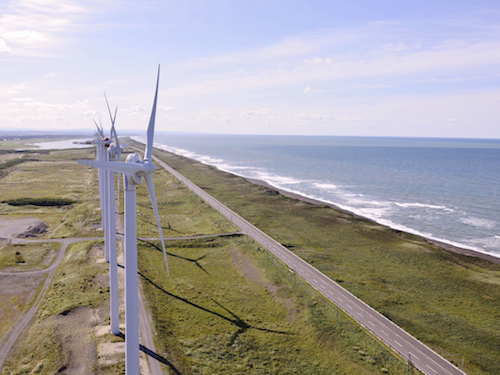 Horonobe Town, Hokkaido. At the Otonrui Wind Power Station, you will find 28 wind turbines along the coastline. The northwestern coast of Hokkaido gets a lot of wind. And it is said that if they could build an offshore wind farm there, it could potentially generate a couple million kWh of energy.
Horonobe Town, Hokkaido. At the Otonrui Wind Power Station, you will find 28 wind turbines along the coastline. The northwestern coast of Hokkaido gets a lot of wind. And it is said that if they could build an offshore wind farm there, it could potentially generate a couple million kWh of energy.
Another issue we have to address to help make renewable energy more widespread is "deregulation." Thermal power plants can be built near demand, but wind farms have to be built where there are strong winds, and geothermal power plants where there is a lot of geothermal heat. So with renewable energy, there are limitations as to where they can be built. And when building power plants, a lot of regulations apply, e.g. regulations about the use of government-owned property, farmland, natural parks.
Moreover, environmental impact assessments tend to that take too long. If these regulations are relaxed and it takes less time to get building permits and for various other procedures, we will be able to build more power plants.
These regulations were originally drafted when people didn't believe that it was necessary to make renewable energy more widespread. But in order to make the shift to new, green energies, some things need to change and or be relaxed. Not only do we need the local community's understanding, we also need to overcome such regulations.
目次へ移動 About the feed-in-tariff
Q: Will the availability of renewable energy change with the feed-in-tariff (FIT), which began in the summer of 2012?
Murakami: Under the feed-in-tariff (FIT), if people who created renewable energy wish to supply electricity, the utilities companies are required to purchase all of the energy during the timeframe and at the price set by the government.
In comparison to conventional fossil fuel power generation, renewable energy facilities are more costly to build. The cost of burning fossil fuels like petroleum and natural gas to create energy is 9.5 yen per 1kWh, whereas renewable energy with lower generation efficiencies cost much more. Solar power generation costs about 40 yen, and other renewables cost around 20 yen give or take. If things don't change, the renewable energy business will not be lucrative and therefore there won't be any newcomers to the business. That is why the government implemented the FIT scheme in July 2012, which sets specific timeframes and prices for purchasing renewable energy, to make it easier to forecast return of investments and to amplify the renewable energy market.
Utilities companies now must purchase electricity at higher prices than before. Thus, they pay for the difference by charging a higher rate to users. This is the renewable energy surcharge you see on your electricity bill every month. If a household uses 7,000 yen per month on electricity, they would be paying around 120 yen out of the total for renewables (prices as of 2013). Another key point of this scheme is to get all of us who use energy involved in promoting renewable energy.
Actually, spearheaded by Germany, other countries implemented the FIT a long time before Japan. And as a result, green energy has already become more widespread in these countries.
Continuing to implement the FIT on one hand, and streamlining the business environment for renewables through deregulation and upgrading power grids on the other. If these 2 aspects can be maintained, renewable energy will become more and more widespread in Japan. Currently renewables only account for 1.6% of all electricity generated, but some say that this may even grow to be more than 10% by 2030. If this can be realized, together with large-scale hydraulic power generation Japan can procure more than 20% of the energy it needs domestically, thereby creating a stable, supply of energy that will help support our lifestyles.
目次へ移動 Our energy literacy
Q: What can each and every one of us do to help make renewable energy more widespread?
Murakami: First of all, it's important to become interested in energy and think about where the energy we use is being created, from what it is created. Energy is an essential building block of our lives, and even our safety. If we want to keep on living the way we have, and secure a stable energy supply, we need an alternative to fossil fuel imports. A mid to long-term vision of 10 to 20 years is necessary to make the shift to a new energy source. For children of the future, and for Japan's future, our generation must define a direction and act immediately.
We need the understanding of energy professionals involved in the business, as well as a higher energy literacy of each citizen, who choose electricity or show understanding for deregulation. And of course it is important to curtail our energy consumption. To what extent will Japan be able to integrate renewables for its future? The answer to this question lies with us, with our resolve and the choices we make.
目次へ移動 Fukushima Floating Offshore Wind Farm (Fukushima Forward)
目次へ移動 Team Japan's endeavor - The world's first offshore wind power generation
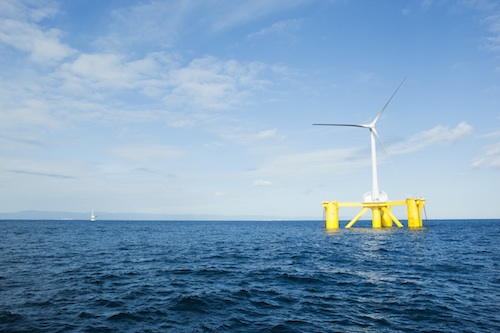 The substation (left) and wind turbine generator (right) at the Fukushima Floating Offshore Wind Farm demonstration project brought to life by the consolidation of Japan's state-of-the-art technologies.
The substation (left) and wind turbine generator (right) at the Fukushima Floating Offshore Wind Farm demonstration project brought to life by the consolidation of Japan's state-of-the-art technologies.
Two and a half hours from the port of Onahama in Iwaki City, Fukushima Prefecture, the towering sight of the substation, "Fukushima Kizuna" welcomed us. And approximately 2km ahead, we saw the offshore wind turbine, "Fukushima Mirai." Both were erected in 2013 as part of the Fukushima Floating Offshore Wind Farm. "Fukushima Mirai," which measures 80m across and boasts a maximum output of 2MW, is 106m tall. The 60-meter tall substation, "Fukushima Kizuna" is also a looming site. It was truly unbelievable to think that these huge buildings floating in the ocean are creating electricity.
"The floating structure is like a ship in a way. It's anchored by a special, massive chain to withstand even a wind speed of 70m/s," explained Mr. Jun Wakui from the Iwaki branch of Marubeni Corporation, who accompanied us to the wind farm.
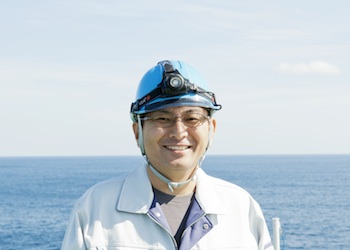 "Because many companies are taking part, it has been a great opportunity to learn about advanced technologies from a wide range of fields." said Mr. Wakui.
"Because many companies are taking part, it has been a great opportunity to learn about advanced technologies from a wide range of fields." said Mr. Wakui.
November 11, 2013. The blades of the wind turbine finally began to turn and the electricity began traveling to land via the substation. By 2015, 2 large, 7MW wind turbines will be added, and the 3-year experimental study will begin in full swing. What hopefully lies beyond is the commercialization of the world's first offshore floating wind farm.
This project launched at the behest of the Ministry of Economy, Trade and Industry, is led by Marubeni, and involves a consortium of 10 Japanese companies including Mitsui Engineering and Shipbuilding Co., Ltd., Mitsubishi Heavy Industries, Ltd., Nippon Steel and Sumitomo Metal Corporation, Japan Marine United Corporation, and the University of Tokyo. The project began around 6 months after the earthquake, and the disaster at the Fukushima Daiichi Nuclear Power Plant. It took everyone by surprise that so much has been accomplished in 2 years.
"In comparison to the way things were done in Japan in the past, this project has moved forward at amazing speed. It was important for our project to take shape and become visible to show everyone that we're making progress and we are heading towards recovery. That is why we wanted to have the wind turbine floating offshore and creating power as soon as possible so that it may serve as a symbol of Fukushima's recovery," explained Mr. Tomofumi Fukuda, the Fukushima Forward project leader/integrator, and General Manager of Domestic Power Project Development of Marubeni Corporation. Although he has been involved in energy projects abroad for 25 years, this was his first time building an offshore wind farm.
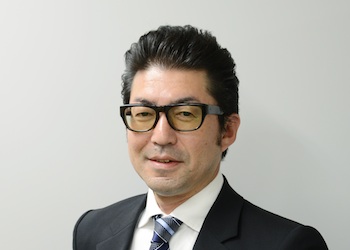 "I have worked on energy projects all around the world, but it's my first time being involved in an offshore wind farm project. I continue to give it my all as I strongly believe that only I can make this happen," said Mr. Fukuda.
"I have worked on energy projects all around the world, but it's my first time being involved in an offshore wind farm project. I continue to give it my all as I strongly believe that only I can make this happen," said Mr. Fukuda.
This project, which has combined many "first of its kind in the world" technologies, is drawing much attention from many countries that want to make offshore wind power generation more widespread.
"A wind farm with numerous floating wind turbines, a floating substation, and a special power cable that connects the wind turbines and the substation. These are all new to the world. The 7MW wind turbine that we will see in the future is also a world's first. These are all brought to life by Japan's technological prowess," explained Mr. Fukuda. Conventional offshore wind turbines that are creating energy in Europe and other regions have monopiles that are drilled into the seabed rock.
"Wind turbines with a drilled monopile foundation are suited for seas that stay shallow for quite a ways offshore, but for Japan's deeps seas, the floating type is better suited. With the floating type, you can also move it anywhere where there are strong winds or a substation to create energy. When thinking about the future of offshore wind power generation, the floating wind farms have far greater potential."
Some of the companies that are involved in the project have actually been developing these technologies from even before the earthquake, with the belief that someday Japan will need offshore wind farms. The launch of this project has speeded things along. Having said that, the waves and currents off the shores of Fukushima where the warm and cold currents converge were especially difficult, and thus required the highest skills from the engineers.
For example, the world's first floating substation facilities were created by Hitachi Ltd. Traditionally, the facilities in substations were vulnerable to vibrations or rocking, but Hitachi incorporated many of its advanced technologies so that the substation could continue to forward large capacities of electricity even when the substation is tossed to and fro by the waves. The power cables connecting the floating wind turbine and substation also have to send a large capacity of energy amid strong currents and waves. The special, versatile cable was developed by Furukawa Electric Co., Ltd. This was also the first undertaking of its kind in the world.
Although the wind turbine has begun to generate energy already, the observation facility created with the offshore substation continues to develop technologies for offshore wind power generation and gather data about oceanographic phenomena and climate. Team Japan's valiant challenge is still ongoing.
目次へ移動 Transforming Fukushima into a green industry hub for wind turbines
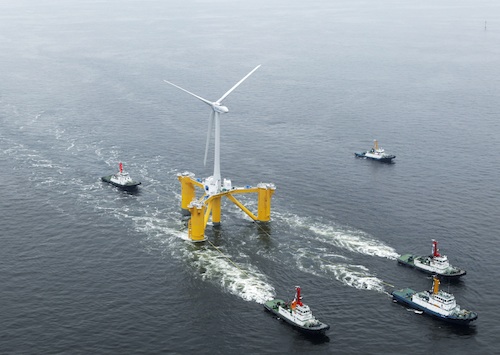 "Fukushima Mirai," the floating offshore wind turbine, was towed from the Tokyo Bay to Fukushima after being assembled at the docks of Mitsui Engineering and Shipbuilding Co., Ltd., in Ichikawa City, Chiba Prefecture. The 2 wind turbines that will join the facility in 2015 are twice the size of this turbine. It won't be long before we see wind turbines as big as the skyscrapers in Shinjuku. (Photograph by: Fukushima Offshore Wind Consortium).
"Fukushima Mirai," the floating offshore wind turbine, was towed from the Tokyo Bay to Fukushima after being assembled at the docks of Mitsui Engineering and Shipbuilding Co., Ltd., in Ichikawa City, Chiba Prefecture. The 2 wind turbines that will join the facility in 2015 are twice the size of this turbine. It won't be long before we see wind turbines as big as the skyscrapers in Shinjuku. (Photograph by: Fukushima Offshore Wind Consortium).
It has also been tough for people working on-site. "In the beginning, we were blown away by the amount of energy produced by the waves offshore. It surpassed our expectations," reflected Mr. Wakui. They are still working on how to access the floating facilities like wind turbines and substations that are less affected by oceanographic phenomena. Tasks that are quite easy to perform on land can be quite difficult out at sea.
"Of all the floating methods, we've employed the semi-sub method. This allows us to have a shorter draft, and therefore enables us to tow the floating structure into ports with shallow waters. What this means is that we don't have to build or maintenance the wind turbines out at sea; we can do it right in the port," explained Mr. Fukuda.
Mr. Wakui, who has moved to Fukushima to oversee this project, has a vision for the future.
"A truly extensive range of industries are involved in the creation of wind turbines like the electrical equipment manufacturers that create generators for the wind turbines, the steel processing industry that produce steel used for the towers, manufacturers of the blades and nacelles, and institutions that inspect the wind turbines. One day we hope Fukushima will become the center of the wind turbine industry. Not only can the energy created from wind power be bought and sold, we hope that it can also help clean up the ocean, and also explore new methods for the fishing industry, like using the floating structure for fish and shellfish cultures. We hope to look for ways to coexist with people in the fishing industry."
This project is about developing marine resources, says Mr. Fukuda. Unlike fossil fuels buried in the seabed, offshore winds are an infinite resource.
"If this experimental research project goes well, technologies for wind power generation will become a regular staple in Japan. And if storage battery technologies that are essential to making renewables more widespread become more advanced, we may not have to depend on importing energy resources. Theoretically, wind power generation has the potential to cover Japan's national energy requirements, so the industry has an impressive potential for growth."
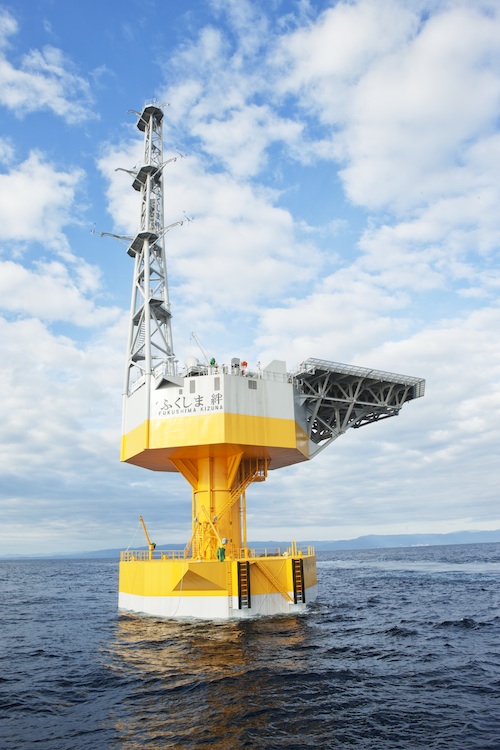 "Fukushima Kizuna," the world's first floating substation. From the bottom of the floating structure, the substation measures 111m in height.
"Fukushima Kizuna," the world's first floating substation. From the bottom of the floating structure, the substation measures 111m in height.
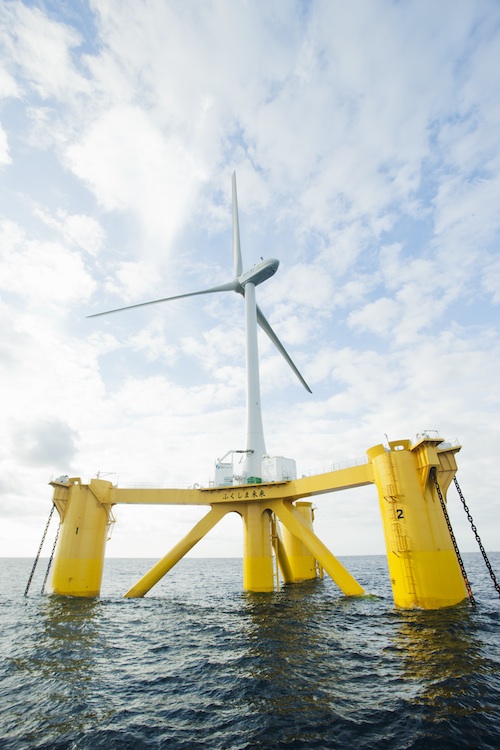 The 2MW wind turbine, "Fukushima Mirai." Each floating structure is securely anchored to the seabed by 6 chains, 830m long, weighing 330t.
The 2MW wind turbine, "Fukushima Mirai." Each floating structure is securely anchored to the seabed by 6 chains, 830m long, weighing 330t.
目次へ移動 Fujino Denryoku - the power of communities
目次へ移動 A lifestyle with choices

Twilight - the lights on the stage in the dim campus turned on, and the annual "Light Festival" began. The electricity used at this art festival was created onsite from renewable energy by "Fujino Denryoku." When you hear the words, "Fujino Denryoku," or Fujino Utilities, you may think of utilities companies like Tokyo Electric Power Company or the Kansai Electric Power Co., Inc., but Fujino Denryoku doesn't sell electricity. It's a group of people who wish to create energy themselves and to support local communities.
The group was formed after the blackouts and the accident at the nuclear power plant after the Great East Japan Earthquake in 2011. After experiencing first hand the vulnerability of a society that relies solely on large-scale power generation, the citizens group in the Fujino region of Kanagawa Prefecture established Fujino Denryoku.
Fujino with its beautiful satoyama has long been known for "forests, lakes, and art." It has continued to attracted many artists over the years. For example, Tsuguharu Fujita moved to Fujino to get away from the Pacific War. Transition town activities (to change society's dependence on fossil fuels) originated in the UK in 2005, but Fujino is where the grass roots activities for transition town began in Japan. The citizens group, "Transitions Fujino" is trying to make this transition with regional currencies, local production and local consumption of produce, as well as with many other initiatives. Fujino Denryoku is one such group, which has stood up to change the way things are with respect to electricity.
Mr. Dentetsu Odajima, the representative of Fujino Denryoku, told us that what has provided the momentum for the project was the large-scale black outs on 3.11 and the planned rolling blackouts that followed.
"Although it doesn't directly put our lives at risk, 'not having electricity' made us feel an indescribable anxiety. I was surprised that not having electricity could physically and emotionally affect us so much."
But there was one chiropractic clinic that continued to stay in business even during the blackout. They had installed a solar panel even before the earthquake. "The light at the chiropractic clinic was a very reassuring presence."
Being able to independently supply the basic level of energy you need in case the power supply from large-scale utilities companies is interrupted. He has never thought that something like this would be possible, but there was someone quite close by who was already doing this.
After the nuclear accident, many people began to question society's dependence on nuclear energy. But at the moment, individuals can't choose what kind of electricity they use. If we could supply electricity ourselves, we can solve 2 problems.
"We don't want to separate our region from the large-scale power grid, and become completely independent. We want to have choices in case of an emergency."
This attitude applies whether it's electricity, regional currency, or food. "Even if the national, large-scale distribution network stops, a subsistence lifestyle can be maintained in the region or home. We're not suggesting that we live only on that and live meager lives. It's sometimes good to eat out and be a bit extravagant, too."
Perhaps the activities of Transition Fujino and Fujino Denryoku have been ongoing for a long time, and have been understood by many people because they believe we shouldn't be too stoic, that we shouldn't force ourselves to abstain too much.
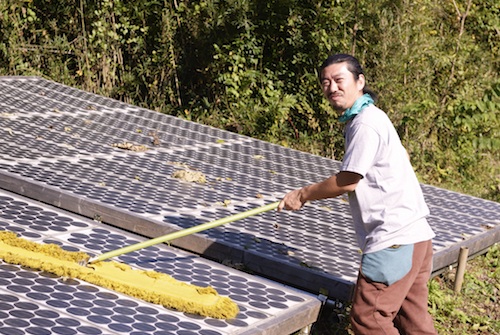 Mr. Dentetsu Odajima cleans the solar panels in preparation for the festival.
Mr. Dentetsu Odajima cleans the solar panels in preparation for the festival.
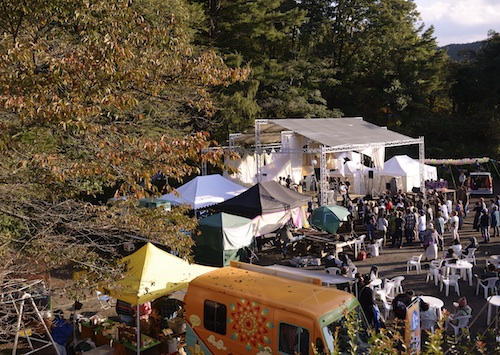 The artistic "Light Festival" held at Fujino Denryoku's headquarters, the old Makisato Elementary School, celebrated its 10th anniversary in 2013. Each year they welcome 7,000 visitors from the region, other parts of Japan, and from abroad.
The artistic "Light Festival" held at Fujino Denryoku's headquarters, the old Makisato Elementary School, celebrated its 10th anniversary in 2013. Each year they welcome 7,000 visitors from the region, other parts of Japan, and from abroad.
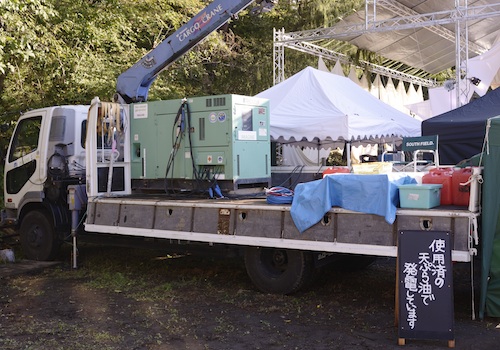 The electricity necessary for the festival was created from solar cells and biodiesel power generation fueled by used tempura oil.
The electricity necessary for the festival was created from solar cells and biodiesel power generation fueled by used tempura oil.
目次へ移動 "Do it ourselves, electricity!" workshops
Fujino Denryoku undertakes a wide range of activities, but one of the most famous one is the "Do it ourselves, electricity!" workshop where participants create a 50W mini solar power generation system on their own.
You don't need any special skills or knowledge. Many of the participants pick up tools they've never touched before in their lives to connect panels, batteries, and inverters together.
Mr. Odajima not only teaches participants about how to connect the different parts, but also some basics about electricity, like what watts (electrical power), watt-hour (electrical energy), direct and alternating currents are, and when such knowledge may come in handy.
"The environment in which the system is installed and operated is different for each home, and there isn't someone there at home that you can turn to for help, so it's good to understand the basics, and when you understand the basics, you can take the system home and use it for various purposes."
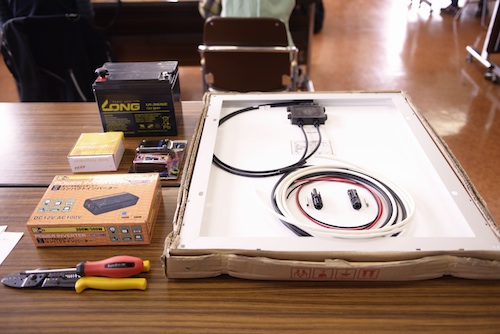 Solar panels and batteries, etc. used during the workshop.
Solar panels and batteries, etc. used during the workshop.
After a few hours the system was complete. Everyone's panels began to create energy. This is the moment when you realize that "power generation" doesn't lie solely in the hands of the large utilities companies, that you too can create energy.
Each workshop has 15 to 20 participants. They began organizing these workshops from December 2011, and have already held 120 workshops so far. So more than 1,000 people have built mini solar power generation systems with their own hands. Fujino Denryoku now gets request from all over the country to organize these workshops.
After the earthquake and the nuclear disaster, I am sure that like Mr. Odajima, many people around the world began thinking about how they could source energy without depending on large-scale power grids and fossil fuels or nuclear energy. Perhaps the workshops organized by Fujino Denryoku provide the means to take the first step towards such a self-sufficient lifestyle.
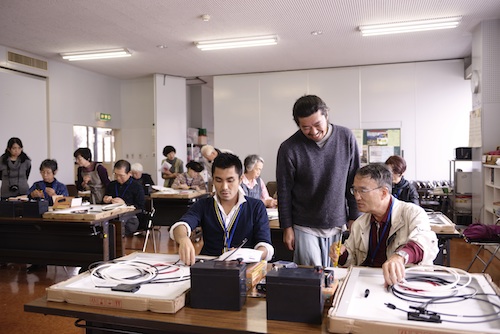 This workshop was held at the consumer center in Hamura City, Tokyo. Men and women of all ages and backgrounds took part. Following Mr. Odajima's instructions, everyone built his or her own solar power generation systems without any hiccups.
This workshop was held at the consumer center in Hamura City, Tokyo. Men and women of all ages and backgrounds took part. Following Mr. Odajima's instructions, everyone built his or her own solar power generation systems without any hiccups.
There are people who are having a great time taking the next step. For example, one person strapped the solar panel to a cart, to create a mobile power generator. When I saw the picture of him and his panel, it was as though the panel had become his pet. You can tell that he really loves his panel.
Mr. Odajima continued, "This also helps people think proactively about how they would be able to live solely on the energy they create. So it's not only about saving energy. People can have fun being creative about how they can live within the limits of the energy they can create.Fujino Denryoku's office actually runs solely on the energy created by these solar panels. It's not about abstaining, rather, we want people to be creative and have fun. We hope to be able to share such fun with many people."
Fujino Denryoku's office is located in the old Makisato Elementary School, which closed down in 2003. "Makisato Labo," is a project, which promotes the reuse of this school as ateliers for artists. To share the activities of these artists with the community, an event was held at the school. This is how the "Light Festival" came about.
Mr. Odajima moved to Fujino in 2004, after seeing the brochure of the very first Light Festival and decided to take part.
A shroud of total darkness began to spread across the sky, and the Light Festival was reaching its climax. This festival, which artfully combines light and sound, fascinated thousands of visitors. The locally produced, locally consumed electricity is created from natural energy, as well as another form of renewable energy, "the power of communities."
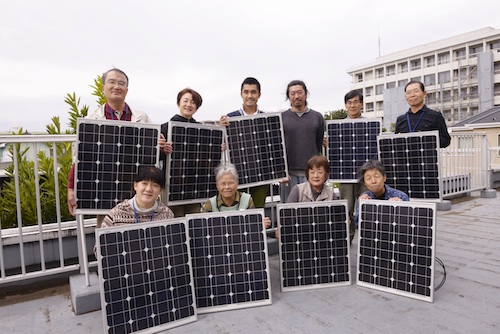 One of the participants said, "I'm going to take this panel home, and think about what I can use it for." In this way, each participant takes the first step to "creating energy himself or herself."
One of the participants said, "I'm going to take this panel home, and think about what I can use it for." In this way, each participant takes the first step to "creating energy himself or herself."
Related websites (in Japanese)
GREEN POWER Project (http://greenpowerproject.jp)
Fukushima Floating Offshore Wind Farm
(http://www.fukushima-forward.jp)
Fujino Denryoku (http://fujinodenryoku.jimdo.com)
Keisuke Murakami:
Born in Tokyo in 1968. Began working for the Ministry of Trade and Industry (now known as Ministry of Economy, Trade and Industry) in 1990. In September 2011, he was put in charge of renewable energy policies as the Director of New and Renewable Energy Division, Agency of Natural Resources and Energy of the Ministry of Economy, Trade and Industry. He has played an integral part in implementing the FIT, which began in the summer of 2012, served as an advisor to renewable energy projects in various regions, and continues to endeavor to make renewable energy more widespread in Japan.
Interviews and report by:
Miho Katsuki (Interview / Fukushima), Eri Eguchi (Fujino Denryoku)
Photographs by:
Satoshi Nagare (Fukushima), Tadayuki Aritaka (Hokkaido / Fujino Denryoku)
Cooperation:
Ministry of Economy, Trade and Industry, Agency for Natural Resources and Energy, New and Renewable Energy Division
Edited by: Soichi Ueda (Think the Earth)
Translated by: Yuri Morikawa (oxygen inc.)















